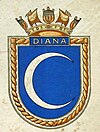 HMS Diana at a buoy
| |
| History | |
|---|---|
| Name | Diana |
| Ordered | 2 February 1931 |
| Builder | Palmers Shipbuilding and Iron Company, Hebburn-on-Tyne |
| Laid down | 12 June 1931 |
| Launched | 16 June 1932 [1] |
| Completed | 21 December 1932 |
| Motto |
|
| Fate | Transferred to the Royal Canadian Navy on 6 September 1940 |
| Badge | |
| Name | Margaree |
| Namesake | Margaree River |
| Commissioned | 6 September 1940 |
| Honours and awards | Atlantic 1940[2] |
| Fate | Sunk following collision, 22 October 1940 |
| General characteristics as built | |
| Class and type | D-class destroyer |
| Displacement |
|
| Length | 329 ft (100.3 m) o/a |
| Beam | 33 ft (10.1 m) |
| Draught | 12 ft 6 in (3.8 m) |
| Installed power | 36,000 shp (27,000 kW) |
| Propulsion |
|
| Speed | 36 knots (67 km/h; 41 mph) |
| Range | 5,870 nmi (10,870 km; 6,760 mi) at 15 knots (28 km/h; 17 mph) |
| Complement | 145 |
| Sensors and processing systems | ASDIC |
| Armament |
|
HMS Diana was a D-class destroyer of the Royal Navy. Ordered in 1931, the ship was constructed by Palmers Shipbuilding and Iron Company, and entered naval service in 1932. Diana was initially assigned to the Mediterranean Fleet before she was transferred to the China Station in early 1935. She was temporarily deployed in the Red Sea during late 1935 during the Abyssinia Crisis, before returning to her duty station where she remained until mid-1939. Diana was transferred back to the Mediterranean Fleet just before the Second World War began in September 1939. She served with the Home Fleet during the Norwegian Campaign. The ship was transferred to the Royal Canadian Navy in 1940 and renamed HMCS Margaree. She served for just over a month with the Canadians before being sunk in a collision with a large freighter she was escorting on 22 October 1940.
- ^ The Times (London), Thursday, 16 June 1932, p. 4
- ^ "Battle Honours". Britain's Navy. Retrieved 14 September 2014.
